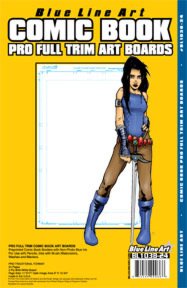How to Draw Comics 101: Choosing Paper
When I made my first attempt at drawing a comic with the intent of publishing, I had a hard time finding the right paper. This was about fifteen years ago and I knew that most comics were drawn larger than print size (11×17 for the standard American comic) but I couldn’t find that size anywhere. I drove to every art store in town and a few out of town. Nothing. Finally, I ran across what was then probably the only online place that sold that size paper and as a bonus had the template printed right on the page. Fortunately, the market is a lot different today and companies are catering to the comic book artist with products that were considered specialty items back when I started. If you’re new to making comics, finding the right paper you need is the easiest part of the process. If I were teaching How to Draw Comics 101 here’s what I’d say about choosing paper.
PAPER SIZES
For a book published at the standard size for American comics, the artwork is drawn larger than the finished product. 11×17 is pretty much standard, but you can draw smaller (or bigger) as long as the image you draw fits the roughly 6×10″ area that the book will be printed at when reduced. Pads of 9×12 Bristol Board (a very common type of paper used for illustration) are easy to find if you want to draw smaller. You could even use 8.5×11 copy paper with the right template for your drawing area.
WEIGHT & THICKNESS
The brand of Bristol Board that I typically use (Strathmore) comes in different series of papers that are progressively thicker. I’ve used the 200 series, but in my opinion that series doesn’t hold up very well (the layers of the board seemed to come apart at the corners.) I’ve been using the 300 series for years and it works just fine for me. The 500 series is really nice, but a tad more expensive. If you’re just starting out I’d try the 300 series and go from there. Without going into paper weights and all that, just remember the thicker paper, the better it will hold up. Bristol Board is a good type of paper to use and holds up well (except for the 200 series mentioned above.) I’ve never used what’s marketed as Illustration Board, but my understanding is that it’s good, but not intended to hold up as well over time. If you’re wanting a piece of art that’s on a durable surface that’s both meant to be held onto, framed, or sold to fans and collectors, then I’d say stick with Bristol Board.
BRANDS
Strathmore
The Strathmore pads of Bristol Board are pretty much everywhere. Go to any art store or online retailer and you can find 11×17 Bristol in 200 or 300 series. As more companies have realized the market among comic artists they’ve packaged them with comic panels on the front so they’re easy to find.
TIP: Buying in a chain art store like Micheal’s can be twice as expensive as ordering somewhere online like dickblick.com. If you’re just going to buy one thing, though, go to the store’s website and get their weekly coupon. They always offer 40% one item–which brings the price of that one item down to what you’d pay online.
Canson
Canson was probably the first company I noticed that started to put their comics and manga papers in stores. I used their pads of 11×17 paper for a while when they first came out and found them a pretty good drawing surface. They also have smaller sized 8.5×11 pads. And the good thing is they already have the drawing areas pre-ruled.
Blueline Pro
This was the first company I found way back when I first started. Our studio used to get paper from them with our logo and drawing template printed on and the quality was fine. They offer different paper sizes and weights as well.
Eon
I’ve never used Eon boards, but I know a few people who have. They’ve been around for a while but I can’t speak to their quality. Give them a try and let me know what you find! It’s definitely a lot easier to find the materials you need to get started making comics than it used to be, especially when choosing paper. If there’s something I’ve missed, let me know in the comments below. And if you have a brand to try, let me know that too.



